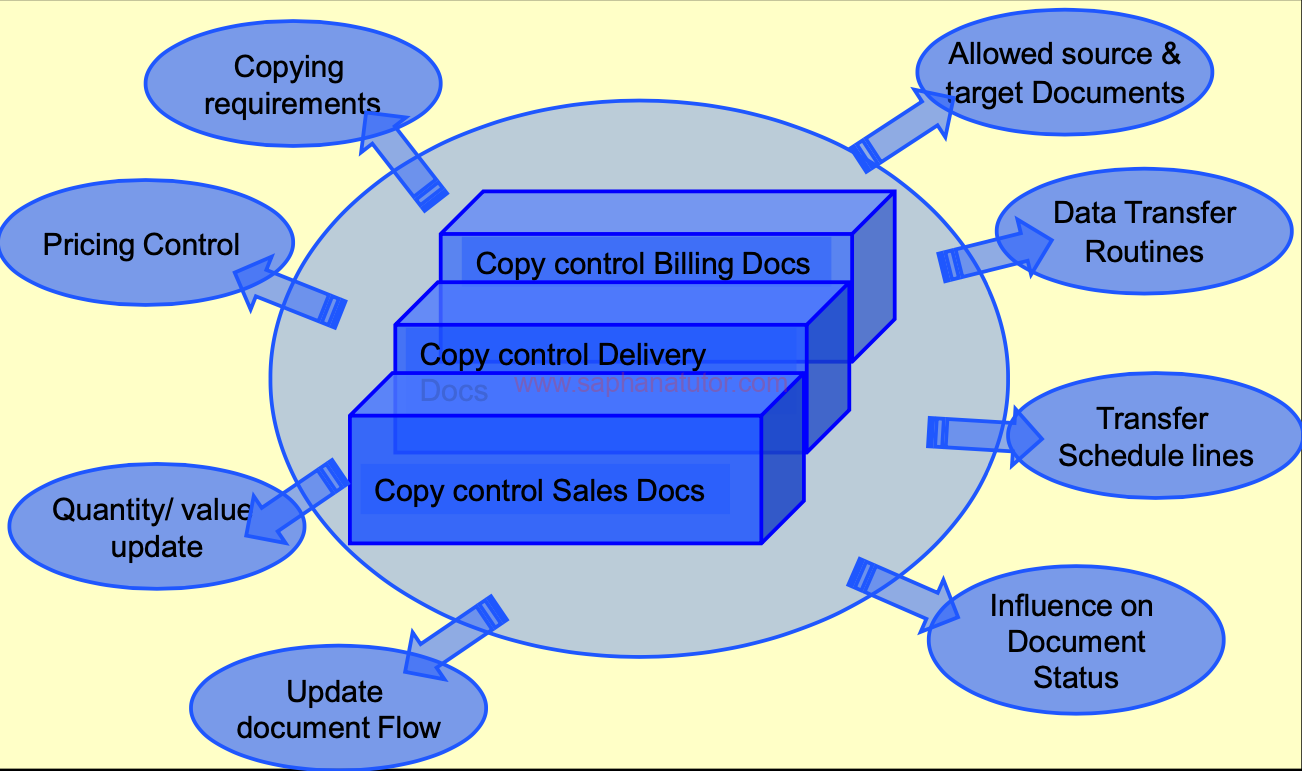SAP SD (Sales and Distribution) is a critical component of the SAP ERP system, playing a pivotal role in managing sales and distribution processes in organisations. One of the key features in this module is the concept of SD Copy Controls, which is essential for streamlining sales transactions and ensuring data consistency. In this blog post, we’ll delve into the purpose and uses of SD Copy Controls, simplifying these concepts for better understanding.
Understanding SD Copy Controls
At its core, SD Copy Controls are rules that govern how data is transferred from one document type to another within the SAP SD module. This functionality is crucial because it ensures that important information is accurately and efficiently carried through various stages of the sales process.

Purpose of SD Copy Controls
Common Scenarios in Sales & Distribution
Standard Order Scenario
- Process Flow: Quotation → Sales Order → Delivery → Invoice.
In this scenario, SD Copy Controls facilitate the transition of data from the quotation phase right through to invoicing. For instance, data from a Quotation is copied to create a Sales Order, then from the Sales Order to Delivery, and finally from Delivery to the Invoice.
Returns Process Scenario
- Process Flow: Invoice → Return Sales Order → Return Delivery → Credit Notes.
Here, SD Copy Controls manage the flow of data during product returns, ensuring that information from the original invoice is accurately reflected in the return sales order and subsequent documents.
Credit Memo Process Scenario
- Process Flow: Invoice → Credit Memo Request → Credit Memo.
This scenario involves the creation of credit memos, where data from the original invoice is crucial for generating subsequent documents.
Uses of SD Copy Controls
- Ensuring Data Consistency: One of the primary uses of SD Copy Controls is to maintain data consistency across different sales documents. This consistency is key to ensuring that information is accurately reflected throughout the sales process.
- Reducing Manual Entries: By automating the transfer of data between documents, SD Copy Controls significantly reduce the need for manual data entry, thereby minimising the risk of errors.
- Handling Unique Data Changes: In cases where similar entries are required with unique changes (like condition records), SD Copy Controls provide the flexibility to make these adjustments while maintaining data integrity.
- Streamlining Sales Transactions: SD Copy Controls play a vital role in streamlining the entire sales transaction process, making it more efficient and less prone to errors.
SD Copy Controls – Challenges
Challenge 1: Copying Only Relevant Data to Subsequent Documents
One of the key challenges in SD Copy Controls is the ability to identify and copy only the data that is relevant for the subsequent document in the sales process. This is crucial because each type of document in the sales cycle (like quotations, sales orders, delivery notes, and invoices) requires different kinds of information. Here’s how this challenge is typically addressed:
- Customizing Copy Control Settings: SAP allows for detailed customization in the copy control settings. This means businesses can define what specific data should be transferred from one document to another.
- Using Copying Requirements: SAP provides a feature known as copying requirements, which are essentially conditions that determine when and what data should be copied. These requirements can be tailored to ensure only pertinent data is transferred.
- Data Filtering Through Routines: Programming routines can be used to filter out unnecessary data. These are custom codes written in ABAP (SAP’s programming language) that specify which data fields should be included or excluded in the copy process.
Challenge 2: Ensuring the Copy of Important Business Data with Updates
Ensuring that critical business data such as pricing, exchange rates, and invoiced quantities are not only copied but also updated as needed, presents another significant challenge. This data is dynamic and can change frequently, impacting the accuracy of the sales documents. Addressing this challenge involves:
- Dynamic Data Handling: Pricing conditions, exchange rates, and quantities often need to be recalculated or updated based on the current situation. SAP SD provides functionalities to handle these updates dynamically during the copying process.
- Pricing Updates: For pricing data, SAP allows the re-determination of prices during the copy process. This means that the pricing conditions in the new document can be recalculated based on the most current pricing data.
- Exchange Rate Fluctuations: Exchange rates can fluctuate daily. SAP has mechanisms to update these rates in the copied document, either by using the latest rate or a specific rate as defined in the sales contract.
- Quantity Adjustments: Quantities invoiced can differ from the order quantities. SAP’s copy control can be configured to reflect these changes accurately, ensuring that the quantities in delivery and billing documents are correct.
Conclusion
In the SAP SD module, SD Copy Controls are an indispensable feature, significantly impacting the efficiency and accuracy of sales processes. By understanding their purpose and uses, businesses can better manage their sales and distribution activities, ensuring seamless and error-free transactions. Whether you’re dealing with standard sales orders, returns, or credit memos, SD Copy Controls ensure that your data is consistently and accurately reflected across all relevant documents, streamlining your sales operations in SAP.
Join us in the upcoming SAP SD tutorial where we’ll dive into key topics like Copying Requirements, Document Flow Updates, and Data Transfer Routines. Discover how to manage source and target documents, schedule lines, and ensure data integrity across your SAP SD processes for efficient sales distribution.
